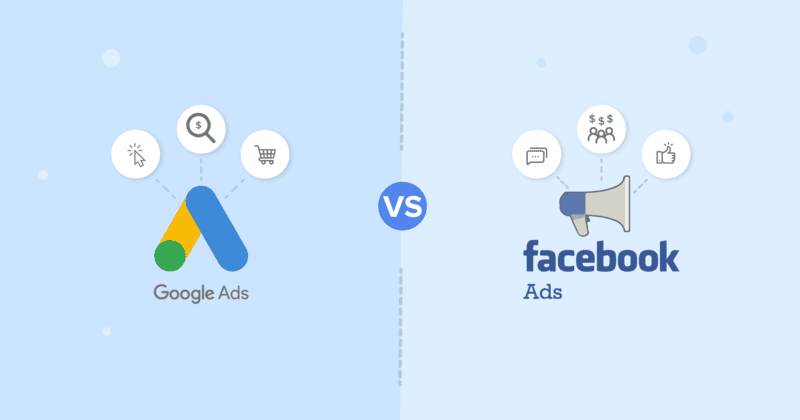Facebook Ads Vs. Google Ads: Comparing Advertising Platforms

In the realm of digital marketing, the two most prominent platforms are Google Ads and Facebook Ads. Both platforms offer unique benefits and can significantly influence the success of online advertising campaigns.
This article aims to provide a comprehensive comparison of these two advertising giants, considering key factors such as audience reach, targeting capabilities, ad formats, cost, and tracking features. It will also delve into the user intent behind each platform and illustrate real-life case studies to provide a practical context.
The objective is to empower marketers with the insights necessary to make informed decisions about which platform will best serve their specific campaign goals. This comparison will not only aid in the understanding of the inherent strengths and limitations of each platform but also illuminate potential synergies when these platforms are employed in conjunction.
Overview of Both Platforms
Exploring the landscape of digital advertising necessitates a comprehensive understanding of both Facebook and Google platforms, which dominate the industry with their unique features and vast reach.
Facebook, a social networking service, offers highly targeted advertisements based on user profiles, behaviors, and social interactions. This platform is renowned for its ability to create a personalized user experience, enhancing the effectiveness of ads by focusing on demographic and psychographic segmentation.
On the other hand, Google, a search engine giant, offers AdWords, a pay-per-click platform. Google Ads primarily targets users based on their search queries, delivering timely and relevant ads. This search-based approach is effective for businesses seeking immediate sales or lead generation.
Thus, both platforms provide distinct opportunities for advertisers to reach their target audience.
Audience Reach and Targeting Capabilities
Distinguishing between the audience reach and targeting capabilities of different online marketing strategies can significantly influence the effectiveness of promotional endeavors. This distinction is particularly crucial when comparing Facebook Ads and Google Ads.
Facebook Ads and Google Ads offer unique advantages in terms of audience reach and targeting:
- Facebook Ads provides access to a user base that exceeds 2.8 billion monthly active users, allowing advertisers to target based on demographics, interests, and behaviors.
- Google Ads, on the other hand, benefits from its expansive network, incorporating search engine results and partner websites, to reach over 90% of internet users.
- In terms of targeting, Google Ads boasts intent-based targeting, capturing users actively searching for particular products or services.
- Conversely, Facebook Ads excels in psychographic and demographic targeting, permitting advertisers to reach users based on their individual characteristics and interests.
Ad Formats and Placements
Delving into the realm of ad formats and placements, it is pertinent to understand the myriad of options available, each with its unique strengths, designed to cater to varied business needs and customer engagement levels.
Facebook offers traditional formats like image and video ads, alongside interactive formats such as carousel, slideshow, and collection ads. These can be placed in locations like the news feed, right column, or within stories.
Google, on the other hand, provides search, display, shopping, video, and app ads. These can appear on Google’s search results, partner websites, YouTube, or within apps.
The choice between these platforms heavily depends on the campaign objective, the nature of the product or service, and the intended audience.
Cost and Bidding Options
A comparative analysis of the cost and bidding options provided by Facebook and Google, two of the dominant online advertising platforms, serves as a crucial factor in determining the efficiency and effectiveness of advertising campaigns.
An examination of Facebook ad costs, which are determined by factors such as ad quality and relevance, audience targeting, and industry competition, will be undertaken.
Concurrently, an exploration of Google ad costs, which are influenced by elements such as keyword popularity, quality score, and advertising network selection, will be conducted.
Discussing Facebook Ad Costs
To understand the potential for campaign success, examining Facebook ad costs reveals an essential aspect of this advertising platform. Factors influencing Facebook ad costs include the ad’s objective, audience, and quality, as well as market competition. Advertisers can choose between cost-per-click (CPC) or cost-per-thousand-impressions (CPM) bidding models.
CPC is advisable when the objective is to drive specific actions, such as website clicks. CPM, on the other hand, is suitable for increasing brand awareness, as it charges for every 1,000 times an ad is shown, regardless of engagement.
The average CPC on Facebook ranges from $0.45 to $3.77, while CPM can range from $5.12 to $7.19. These costs fluctuate depending on industry, audience demographics, and time of year.
Discussing Google Ad Costs
Examining the cost structure of Google’s advertising services reveals a different landscape, with several factors influencing the overall expenses.
Contrary to Facebook, Google Ads operates on a cost-per-click (CPC) model, meaning advertisers pay each time a user clicks on their ad. The average CPC on Google Ads varies widely, ranging from $1 to $2 on the search network.
The cost is influenced by several variables such as industry, keywords, quality score, and competition. High competition and popular keywords tend to drive up costs.
The quality score, determined by factors like ad relevance and landing page experience, can lower CPC if it’s high. Therefore, understanding these factors is integral to managing costs on the Google Ads platform.
Tracking and Reporting Features
Diving into the world of digital advertising, one cannot overlook the importance of robust tracking and reporting features offered by platforms such as Facebook and Google Ads. Both platforms provide marketers with comprehensive tools to analyze campaign performance.
Google Ads offers detailed keyword performance reports, while Facebook Ads provides demographic information about ad viewers. These tools allow advertisers to make informed decisions about campaign adjustments and budget allocation.
However, each platform has unique strengths. Google Ads’ tracking capabilities excel in following the user’s journey through the sales funnel, whereas Facebook Ads’ reporting shines in segmenting audiences based on demographics and interests.
Both platforms offer powerful ways to measure the effectiveness of campaigns, making them invaluable tools for digital advertising success.
User Intent
Understanding user intent plays a crucial role in tailoring and optimizing digital marketing strategies, as it provides insights into the specific needs and wants of the target audience.
The distinction between Facebook Ads and Google Ads can be perceived through the lens of user intent.
- On Facebook, users generally browse casually, not with a specific intent to purchase. This platform is more conducive to brand exposure and audience engagement.
- Google, on the other hand, capitalizes on active search behavior, capturing users who are deliberately seeking information or products, and are thus, more likely to convert.
The choice between the two platforms should be dictated by the company’s specific marketing objectives and understanding of their target audience’s behavior and preferences.
Case Studies and Examples
Analyzing real-world instances and scenarios provides valuable insights into the effectiveness of different digital advertising strategies.
Several case studies exemplify the distinctions between Facebook and Google Ads. For instance, a study by Word Stream found that Facebook Ads were more effective for B2C companies due to its strong targeting capabilities, while Google Ads performed better for B2B, thanks to its broad reach and high intent traffic.
Another example is the fashion retailer, Zara, which utilized both platforms but used Facebook for brand awareness and customer engagement, and Google for driving sales.
These examples underscore the importance of understanding the strengths and weaknesses of each platform and aligning them with the objectives of the campaign for optimal results.
Making the Final Decision
In the realm of digital marketing, the ultimate choice between different advertising channels largely hinges on the specific goals, target audience, and budget constraints of the business.
To illustrate, a comparison between Facebook Ads and Google Ads can be made using the following table:
| Criteria | Facebook Ads | Google Ads |
|---|---|---|
| Reach | Over 2.8 billion monthly active users | Over 3.5 billion daily searches |
| Targeting Options | Detailed demographics, interests, behaviors | Keywords, demographics, device, location |
| Ad Formats | Image, video, carousel, slideshow, collection | Text, image, video, shopping, call-only |
| Cost | Generally less expensive | Can be expensive depending on competition for keywords |
This succinct analysis underscores the necessity of selecting the appropriate platform based on the campaign’s strategic objectives and available resources.
Frequently Asked Questions
How do Facebook and Google Ads handle data privacy and security?
Both Facebook and Google Ads prioritize data privacy and security, implementing robust measures to protect user information. They adhere to strict privacy policies, ensure transparency, and offer users control over their personal data.
What are the customer support options for both Facebook Ads and Google Ads?
Facebook Ads and Google Ads offer extensive customer support options. These include online help centers, community forums, live chat, email support, and phone support, ensuring users receive assistance for any difficulties encountered.
How can I integrate Facebook and Google Ads into my existing marketing strategy?
Integrating Facebook and Google Ads into an existing marketing strategy necessitates a comprehensive understanding of each platform’s distinct functionality. Moreover, one needs to align these functionalities with the overall objectives of the marketing strategy.
Can I simultaneously run campaigns on both Facebook and Google Ads?
Yes, simultaneous campaigns on both Facebook and Google Ads are feasible. This multi-platform approach can optimize exposure and reach, leveraging the unique strengths of each platform to maximize overall campaign effectiveness.
How do updates and changes in platform algorithms affect my ads performance?
Updates and alterations in platform algorithms can significantly impact ad performance. They can alter visibility, reach, and engagement rates, thereby affecting the effectiveness of advertising strategies and the achievement of marketing objectives.






